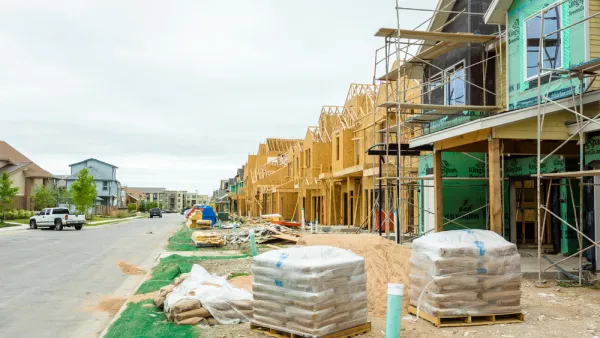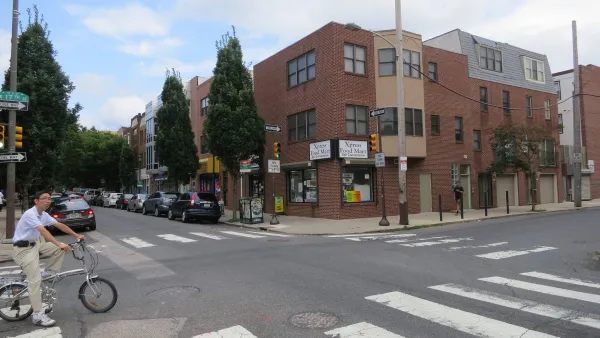I appreciate natural environments. I have always enjoyed walking in wilderness and cycling on rural roads, and I understand the ecological value provided by undeveloped lands, which include clean water, air and wildlife habitat. I also enjoy local fresh vegetables and fruits and so appreciate the value of preserving regional farmlands. Planners call these "greenspace," or more generally "openspace" since some, such as deserts and waterways, are open but not necessarily green.
I appreciate natural environments. I have always enjoyed walking in wilderness and cycling on rural roads, and I understand the ecological value provided by undeveloped lands, which include clean water, air and wildlife habitat. I also enjoy local fresh vegetables and fruits and so appreciate the value of preserving regional farmlands. Planners call these "greenspace," or more generally "openspace" since some, such as deserts and waterways, are open but not necessarily green.
Most people seem to agree: they want to preserve natural environments and farmland. But planners often face conflicts between residents' desire to preserve local openspace and strategic goals to protect regional openspace. Smart growth policies that result in more compact development tend to reduce local but increase regional openspace.
This issue came up when I spoke at a conference last weekend, where I showed data on health, safety and affordability benefits of more compact development (www.vtpi.org/sg_save.pdf), and described Vancouver's EcoDensity program (www.ecodensity.ca) designed to achieve such benefits. An audience member criticized this concept, arguing that, "People need nature to be healthy." She opposes any infill development that displaces greenspace.
I appreciate the intention but believe it is misguided. I certainly agree that urban areas need plenty of parks and gardens, including neighborhood pocket parks for young children, recreational parks for sports, and allotment gardens, so everybody has access to local greenspace. However, infill development, and the transition from suburban to urban conditions, tends to displace private lawns. In a typical situation a developer replaces single-family housing that has about 30% impervious surface with multi-family housing that has 80% impervious surface. Impervious surface increases in that area, but declines per capita and across the region compared with the same number of people accommodated with sprawled development.
Opponents often claim that such infill is ecologically harmful, but what ecological functions do lawns actually fulfill? Lawns cannot be considered wildlife habitat, since most wild animals are considered pests. They absorb precipitation and so reduce stormwater management costs, but because they are heavily fertilized and chemicalled (plenty of "Weed and Feed"), they threaten groundwater quality. Lawns and gardens do tend to reduce heat island effects. In practice, suburban and urban lawns displaced by development are are primarily an aesthetic loss, less land devoted to lawns and gardens which reflect an idealized but artificial landscape, but not much of an ecological loss. True nature is generally rougher, less pretty and unpredictable.
Here are some ways to maintain access to true nature for urban residents:
• Maintain public parks within urban areas, with some areas preserved in semi-natural conditions.
• Maintain regional nature parks.
• Use native plants and habitat landscaping as much as possible.
• Use organic landscape management which minimizes chemical fertilizers and pesticides, to protect water quality, as much as possible.
• Encourage rooftop and wall gardens.
• Welcome true nature.
I support urban gardening, but it should be opportunistic, taking advantage of suitable rooftops and undeveloped land. Cities should avoid restricting development (such as building heights) just to preserve gardens – the economic, social and environmental benefits of infill development are generally much greater than a garden's benefits.
While urban greenspace can sometimes be preserved by building taller buildings, this has disadvantages. Some households prefer private ground-floor entrances, feasible with townhouses and garden apartments which are usually limited to about three stories; beyond four stories residents tend to lose their social connection with the street (it is no longer possible to say hello to friends walking by from your window); and taller building are inhuman in scale. I am not suggesting that cities maintain a rigid four-story limit, but there are extra benefits mid-rise scale.
This is part of a larger debate concerning whether compact development is unhealthy. Many people assume that urban living is psychologically and socially harmful, based on the perception that city residents are more stressed, less friendly, and more likely to be anti-social – an expression of a long anti-urban tradition. Yes, some city neighborhoods have concentrated poverty and related social problems, but other city neighborhoods are quite healthy and happy. Objective research indicates no harmful impacts from the densities commonly found in North American cities (www.vtpi.org/sgcritics.pdf).
Of course, direct environmental impacts are just one of many factors that should be considered when evaluating development policies. More compact and mixed development can provide other savings and benefits including public service and transportation cost savings, traffic safety, plus improved public fitness and health.
Described differently, people who insist on limiting local development to preserve local greenspace are consuming environmental quality by surrounding themselves with pretty lawns and gardens, while people who support infill development are producing environmental quality by reducing the amount of land consumed per capita, and therefore preserving more regional greenspace.
This is not to suggest that everybody should live in urban areas, but if there is unmet demand for such development it is good public policy to accommodate it through smart growth policy reforms.
For More Information
Robert W. Burchell and Sahan Mukherji (2003), "Conventional Development Versus Managed Growth: The Costs of Sprawl," American Journal of Public Health, Vol. 93, No. 9 (www.ajph.org), Sept. 2003, pp. 1534-1540.
Ben Janke, John S. Gulliver and Bruce N. Wilson (2011), Development of Techniques to Quantify Effective Impervious Cover, Center for Transportation Studies, University of Minnesota (www.cts.umn.edu/Publications/ResearchReports/reportdetail.html?id=2058).
Jonathan Levine (2006), Zoned Out: Regulation, Markets, and Choices in Transportation and Metropolitan Land-Use, Resources for the Future (www.rff.org).
Todd Litman (2008), Evaluating Criticism of Smart Growth, Victoria Transport Policy Institute (www.vtpi.org/sgcritics.pdf).
Todd Litman (2009), Understanding Smart Growth Savings: What We Know About Public Infrastructure and Service Cost Savings, And How They are Misrepresented By Critics, Victoria Transport Policy Institute (www.vtpi.org/sg_save.pdf).
Todd Litman (2010), Evaluating Transportation Land Use Impacts, Victoria Transport Policy Institute (www.vtpi.org/landuse.pdf ); originally published in World Transport Policy & Practice, Vol. 1, No. 4, pp. 9-16 (www.eco-logica.co.uk/worldtransport.html).
Todd Litman (2011), "Why and How to Reduce the Amount of Land Paved for Roads and Parking Facilities," Environmental Practice, Vol. 13, No. 1, March, pp. 38-46 (http://journals.cambridge.org/action/displayJournal?jid=ENP); at www.vtpi.org/EP_Pav.pdf. Also see Todd Litman (2011), Pavement Buster's Guide: Why and How to Reduce the Amount of Land Paved for Roads and Parking Facilities, VTPI (www.vtpi.org/pavbust.pdf).
Richard Louv (2005), Last Child in the Woods: Saving Our Children from Nature-Deficit Disorder, Algonquin Books.
William Lucy (2002), Danger in Exurbia: Outer Suburbs More Dangerous Than Cities, University of Virginia (www.virginia.edu), 2002; summarized in www.virginia.edu/topnews/releases2002/lucy-april-30-2002.html
J. Morris and J. Bagby (2008), "Measuring Environmental Value For Natural Lawn And Garden Care Practices," International Journal Of Life Cycle Assessment, Volume: 13, Issue: 3, pp. 226-234.
NAR (2003), Creating Great Neighborhoods: Density in Your Community, The National Association of Realtors, the Local Government Commission and the U.S. Environmental Protection Agency (www.epa.gov/smartgrowth/pdf/density.pdf).

National Parks Layoffs Will Cause Communities to Lose Billions
Thousands of essential park workers were laid off this week, just before the busy spring break season.

Retro-silient?: America’s First “Eco-burb,” The Woodlands Turns 50
A master-planned community north of Houston offers lessons on green infrastructure and resilient design, but falls short of its founder’s lofty affordability and walkability goals.

Delivering for America Plan Will Downgrade Mail Service in at Least 49.5 Percent of Zip Codes
Republican and Democrat lawmakers criticize the plan for its disproportionate negative impact on rural communities.

Test News Post 1
This is a summary

Test News Headline 46
Test for the image on the front page.

Balancing Bombs and Butterflies: How the National Guard Protects a Rare Species
The National Guard at Fort Indiantown Gap uses GIS technology and land management strategies to balance military training with conservation efforts, ensuring the survival of the rare eastern regal fritillary butterfly.
Urban Design for Planners 1: Software Tools
This six-course series explores essential urban design concepts using open source software and equips planners with the tools they need to participate fully in the urban design process.
Planning for Universal Design
Learn the tools for implementing Universal Design in planning regulations.
EMC Planning Group, Inc.
Planetizen
Planetizen
Mpact (formerly Rail~Volution)
Great Falls Development Authority, Inc.
HUDs Office of Policy Development and Research
NYU Wagner Graduate School of Public Service





























